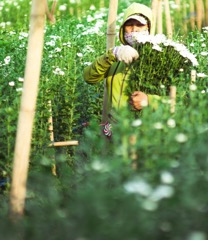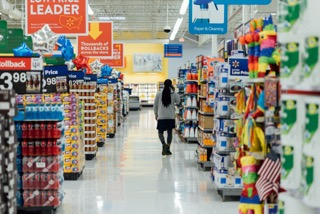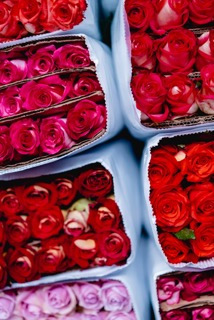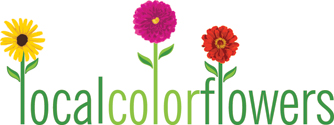LoCoFlo Blog
Tags: At LoCoFlo BookClub Bugs Classes Farmers Flower Club Flower Profile Games Open Studio Hilarious Meet the Owners Nerdy AF Sat@LoCoFlo Stuff You Can Buy
April 25 2021
There Is Not A Cut Flower Shortage
Tags: | By Ian TresseltGuest Blogger |
End Times
Cue the swirly music and flashback to Spring 2020. The nightly news programs suddenly had an interest in the flower industry. The sheer theatrical horror of billions of flowers being discarded proved an apt metaphor for the plague that was descending across the globe. Heaps of (insert beautiful flower here) left to die. The camera pulled back to show the magnitude of the compost. Farmers were ripping plants out of the ground from the root and throwing them away.
Meanwhile, many florists were beginning to feel the pinch. They got through the important Valentine’s Day holiday, but the next string of Spring celebrations looked bleak. Cancellations paired with a general fear of the unknown caused everyone to stop and look to the essentials. Flowers did not make the cut.
Now, it’s Spring 2021. Certain flower Instagram feeds are saying things like “Supply Shortages!” and “Demand Greater Than We Can Handle!” It is not surprising this is happening. Mass-producing flower farms outside of the United States cut tens of thousands of jobs and scaled back their production.
The pandemic's wrath dog-piled onto farms in areas already plagued by political unrest. Production in Columbia, Ecuador, and East Africa, halted.  Western European markets driven by the massive flower farms in the Netherlands were also shuttered, as the countries went into mandatory lockdowns.
Western European markets driven by the massive flower farms in the Netherlands were also shuttered, as the countries went into mandatory lockdowns.
Here in the U.S., with well over 70% of cut flowers grown in California, farmers also felt the blow. Already in competition with the global markets and narrow profit margins to boot, the timing of the shutdown was devastating. The most profitable time of the year for California farmers never happened.
Even before the pandemic, California flower growers were feeling the burn from lower-priced imports. When cannabis was voted legal in 2016, many California farmers were given incentives to grow it and preyed on the opportunity. Flower farms became cannabis farms overnight, reducing the number of cut flowers grown in the United States.
The Problem With Grocery Stores
It takes a hot minute for flower farms to rev back up. With fewer in existence  and a reduced workforce at those still producing, it’s no wonder that wholesalers and distributors have concerns. Like any non-diversified portfolio, relying solely on global imports is bound to have implications. Now, the biggest competitor in the fight to get these blooms is your friendly neighborhood grocery store. The infamous floral department greeting you as the doors swish open has been a scourge on the floral industry for a long time. Wholesalers, let alone small florists can’t compete with these national and international chains. They are gobbling up the flowers. But, they’re also responsible for the shortage.
and a reduced workforce at those still producing, it’s no wonder that wholesalers and distributors have concerns. Like any non-diversified portfolio, relying solely on global imports is bound to have implications. Now, the biggest competitor in the fight to get these blooms is your friendly neighborhood grocery store. The infamous floral department greeting you as the doors swish open has been a scourge on the floral industry for a long time. Wholesalers, let alone small florists can’t compete with these national and international chains. They are gobbling up the flowers. But, they’re also responsible for the shortage.
When the pandemic struck, grocery stores stopped buying flowers. Floral departments were replaced with shelves of toilet paper and bleach. Grocery stores are one of the largest buyers of cut flowers, with nearly 50% of flowers purchased. So, when they stopped purchasing, the disruption was swift.
Now that grocery stores are purchasing flowers again, and have the resources to buy at scale, they are dominating these imports. Simply put, the bulk of cut flower imports are going to them. The quantity at which they can buy far exceeds those of even the largest wholesaler.
Getting From There To Here
It is no mystery that challenges in the global supply chain existed long before COVID hit, but it didn’t help the matter. Look at the recent disruption caused by the Ever Given, a massive cargo ship that got stuck in the Suez canal. That incident proves how fast the global supply chain can break. Industries reliant on imports have to back peddle on promises made to their consumer. This results in dire messaging from some wholesalers and large e-retailers.
The bulk of flowers are imported to the United States in the body of passenger planes. It’s no wonder the limited supply of imported stems is further hindered by the fact that fewer people are traveling. Lockdowns across the globe reduced international air travel by 60%. So even if farms have flowers available, the logistics of getting them to the U.S. are challenging.
In the U.S., the logistics of getting flowers from, say, California to Ohio is just as complicated. There aren't enough truck drivers. According to Aaron Huff, senior editor of the Commercial Carrier Journal, “The trucking industry has about 80,000 fewer available drivers compared to (2019)...The federal stimulus increased unemployment benefits and “couched” a lot of drivers who discovered they could earn more by staying home than being out on the road…” Also, the industry has seen a reduction in training due to lack of interest, continued closures of trucking schools, and the need for social distancing in the schools that remain open.
So, What Are We Paying For?
Many cut flower exporters have systemic challenges they choose to ignore, even before the flowers leave their farms. As workforce reduction was mandated at larger flower farms in Colombia and Kenya, employees, who were barely making a living wage, were now out of a job completely. It would not be hyperbole to call this a humanitarian crisis.
The primary workforce on these farms is female. Because flowers aren’t food, there are fewer regulations. These women are often exposed to harsh chemicals used on cut flowers to increase their shelf life. And since there is no labor union or protection, the hours are long and the tasks are repetitive, resulting in injuries. This limits opportunities for laborers to find other employment. Yet, 80% of the cut flowers sold in this country are purchased from Colombian farms, rife with these labor abuses, overuse of local water sources, and blatant pollution.
There is work being done through Fairtrade flower farms in Ecuador,  but this is just the tip of the iceberg. Consumers need to know where their flowers are coming from. There are other ways to buy a flower that reduces the carbon footprint and assures ethical farming and working practices.
but this is just the tip of the iceberg. Consumers need to know where their flowers are coming from. There are other ways to buy a flower that reduces the carbon footprint and assures ethical farming and working practices.
Why Does Everybody Want Flowers All Of A Sudden?
Minutes after the mass dumping of flowers occurred, there was an ironic turn of fate. Cut flowers, once non-essential, became the darling of the pandemic. People were missing their people. What better way to say “I love you!,” or “I miss you!” than with flowers. The morbid fact that so many people lost and are losing loved ones to the pandemic also raised the profile of flowers. They play a crucial role in the bereavement process.
But, when these people turned to their local florist for help, they were often confronted with shuttered doors and apologies. If florists sourced their flowers from markets reliant on imports, they had no flowers to give. Consumers then turned to large e-commerce flower company’s to send flowers. And, while those companies were not hit as hard, they did have to make some adjustments. Some e-commerce companies struggled with getting flowers to their recipients. They were able to produce the arrangement, but the flowers sat on a loading dock long after the scheduled delivery date due to travel bans. This resulted in public apologies and refunds.
Florists themselves were deemed non-essential during the early days of the pandemic. Many did not receive the PPP loans, but many managed to stay in business through creative pivoting and sourcing from local farms (some, for the first time). With a skeleton staff, owners worked from their homes and often became their delivery drivers. Shops and workspaces were rearranged to address the requisite social distancing. With events canceled or downsized, religious services moved online, and nursing homes off-limits, many shifted to delivery, shortening the supply chain - literally, from farm to table.
The Wholesale Dilemma
Wholesalers and distributors who import flowers from the European, South American, and African farms, have said in no uncertain terms that their inventory will be problematic for the foreseeable future. This is not a short-term problem. They have told florists the following:
- You will experience delays.
- Be prepared to request or receive substitutions.
- Quantities are limited.
The latter two statements are ones that florists who source locally have to maneuver all the time. If wholesalers are forcing florists to address these same questions, then why not look to local farmers for help. There is a better chance at mitigating the risk. By building relationships with local flower farmers, florists will have something on their shelves. That is better than nothing. And, the product is better too.
The Farmer and the Florist Should Be Friends
While the mishegoss was occurring with global trade and logistics, florists who sourced locally were able to keep going without too much disruption. Customers were not turned away because of a shortage of stems. Many independent flower farmers saw their biggest revenues in April, May, and June of 2020. Often, they were selling the only flowers available.
The smaller profit margins in the industry work better for smaller farms. The pandemic did not result in massive flower dumps, and pulling of fields, for small, independent flower farmers. On the contrary, it resulted in increased revenue. It allowed farmers to focus on what they grow, and work toward expanding their inventory.
Florists who establish relationships with farmers can help them think about what they grow from a consumer’s point of view. Good florists know what their customers want, and despite trends, some blooms are always desired. If farmers grow these flowers, they can ensure a certain amount of revenue because they know they will sell.
The two professions need each other. By creating stronger bonds, there is an opportunity to better mitigate what wholesalers are now saying. Florists can have more control of the number of flowers they can purchase, and together, farmers and florists can discuss substitutions for a particular stem that can be grown in their region at different times of the year.
Both farmers and florists can help the consumer celebrate seasonality. The real value proposition in purchasing local flowers is that they are grown in an environment where they thrive, they’re cut and delivered to the florist on the same day, they smell like a flower, and they last far longer than imported stems.
The Opportunity for Local Growers
If ever there was an opportunity to turn the flower trade on its head and bring it back to a locally focussed and more sustainable industry, now is the time. Because of the current void in the wholesale industry, local flower farmers can take advantage of the situation. In a recent interview with Ball-ColorLink Sales Rep and cut flower farm advisor, Dave Dowling, he suggested that the “...worst thing farmers can do (right now) is to stop planting.” Further, he suggested flower farmers increase their planting by 20-40%.
For farmers, florists, and consumers, now’s the time to start building relationships. If you’re a new flower farmer, go meet your local florists and understand what they need. If you’re a new florist, go tour flower farms in your region and see what’s being grown. Purchase some stems. If you are a farmer and are concerned about the quantity you produce, consider joining or starting a Co-Op where your stems can enhance and be enhanced by others. And, If you just love flowers, ask your florist where they came from.
Flowers have always been and will always be about connectivity. The broken global supply chain does not have to be the defining story of this industry. There are plenty of flowers out there. Finding them is as simple as looking in your own backyard.
Tweet





